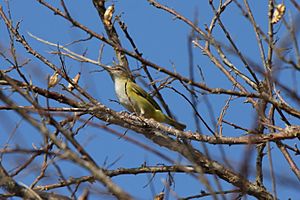Yellow-green vireo facts for kids
Quick facts for kids Yellow-green vireo |
|
|---|---|
 |
|
| In Panama | |
| Conservation status | |
| Scientific classification | |
| Genus: |
Vireo
|
| Species: |
flavoviridis
|
 |
|
| Range Summer breeding range Winter non-breeding range | |
| Synonyms | |
|
Vireo olivaceus flavoviridis |
|
The yellow-green vireo (Vireo flavoviridis) is a small passerine bird from the Americas. These birds are migratory, meaning they travel long distances. They breed in areas from Mexico down to Panama. For winter, they fly south to the northern and eastern Andes mountains and the western Amazon Basin.
Contents
About the Yellow-Green Vireo's Name
The yellow-green vireo was officially named and described by an American bird expert, John Cassin, in 1851. He gave it the scientific name Vireosylvia flavoviridis. The second part of its name, flavoviridis, comes from Latin words. Flavus means "yellow" and viridis means "green." This perfectly describes the bird's colors!
The first bird of this species that was studied and described came from San Juan de Nicaragua. Today, the yellow-green vireo is placed in the group of birds called Vireo. This group was first named in 1808 by a French bird expert, Louis Jean Pierre Vieillot.
There are five different types, or subspecies, of the yellow-green vireo:
- V. f. hypoleucus named by Van Rossem & Hachisuka in 1937. These are found in northwest Mexico.
- V. f. flavoviridis named by Cassin in 1851. These live from north central and northeast Mexico all the way to Panama.
- V. f. forreri named by Madarász in 1885. You can find these on the Islas Marías off western Mexico.
- V. f. perplexus named by Phillips, AR in 1991. These are found in northern Guatemala.
- V. f. vanrossemi named by Phillips, AR, in 1991. These live in southeast El Salvador.
What Does the Yellow-Green Vireo Look Like?
An adult yellow-green vireo is about 14 to 14.7 centimeters (about 5.5 to 5.8 inches) long. It weighs around 18.5 grams (about 0.65 ounces). Its back and top of its head are olive-green. The top of its head is gray with darker edges.
It has a dark line that goes from its beak to its reddish-brown eyes. Above its eyes, there's a white stripe called a supercilium. Its belly and chest are white, but the sides of its chest and body are yellow.
Young yellow-green vireos are not as brightly colored. They have brown eyes and a brownish tint on their backs. They also have less yellow on their undersides.
The yellow-green vireo looks a lot like the red-eyed vireo. However, the yellow-green vireo has much more yellow on its belly. Its gray head also doesn't have a strong black border. Its upper parts are more yellow, and its eye color is different. Sometimes, it can be hard to tell them apart!
This bird makes a sound that is like a nasal nyaaah. Its song is a repeating veree veer viree, fee’er vireo viree. This song is shorter and faster than the red-eyed vireo's song. These birds usually don't sing much when they are in their winter homes.
Where Do Yellow-Green Vireos Live?
Yellow-green vireos breed in many places. They are found from southern Texas in the United States down to central Panama. This includes the western and eastern mountain ranges of northern Mexico.
As mentioned, they are migratory birds. They spend their winters in the northern and eastern Andes mountains and the western Amazon Basin.
These vireos like to live in the middle and upper parts of trees in light woodlands. They also live at the edges of forests and in gardens. You can find them from sea level up to about 1,500 meters (about 4,900 feet) high.
Yellow-Green Vireo Behavior and Life Cycle
Reproduction
The female yellow-green vireo builds a cup-shaped nest. It is about 6.5 centimeters (2.5 inches) wide. She uses many different plant materials to build it. The nest is usually attached to a strong twig, about 1.5 to 3.5 meters (5 to 11.5 feet) above the ground. Sometimes, it can be as high as 12 meters (39 feet).
The female usually lays two or three white eggs with brown marks. She lays these eggs from March to June. Only the female sits on the eggs to keep them warm. However, the male helps her feed the baby birds once they hatch.
These breeding birds return to Central America from early February to March. Most of them fly south again by mid-October.
Feeding
Yellow-green vireos eat insects. They pick them off tree leaves, a behavior called gleaning. They especially like caterpillars and beetles.
They also eat small fruits. This includes mistletoe berries. In their winter homes, they eat fruits from plants like Cymbopetalum mayanum and gumbo-limbo (Bursera simaruba).
Gallery
See also
 In Spanish: Vireo verdiamarillo para niños
In Spanish: Vireo verdiamarillo para niños



